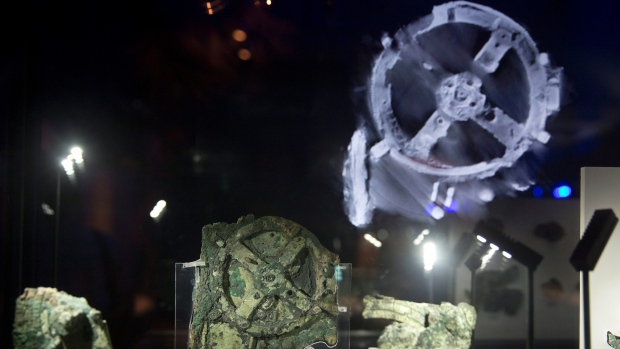
PHOTO: CBC News
In 1901, just off the coast of Antikythera, Greece, the remains of one of the most baffling archaeological finds to date was lifted from a mid first-century BC shipwreck submerged 45 meters under the sea. Most people didn’t think much of the find at first. It paled in comparison to the bronze and marble statues, expensive ancient glassware and ceramics that it had been found with in the shipwreck. But, when several teams began to study it, they found a complex machine made of gears: a multi-layered system that worked much like a clock. It was named the Antikythera Mechanism, after the island it was found by. The artifact was, perhaps, intended to be part of a triumphal parade staged by none other than Julius Caesar himself.
Twelve years ago, two scientists started the painstaking process of using x-ray technology to scan the artifact and analyze the surviving fragments of the Antikythera Mechanism. They wanted to discover how it worked, and were quite successful in that endeavor.
The device is the first known analog computer in the world. It’s likely that this was not the first machine of its type during the Hellenistic period. The technology is too advanced for that. It’s likely that it was constructed sometime around the late second- century BC.
In the late 2000s, the Antikythera Mechanism Research Project suggested that the original prototype for the machine originated in Corinth. This theory is based on the discovery that most of the astronomical calculations written in Koine Greek on the inside of the machine are calculations that could only be made from the Corinth area of Greece. It’s possible, too, that this device had some connection with the school of Archimedes.
The current team working on the device, including Alexander Jones, a professor of ancient science at New York University, has now been able to read about 3,500 characters of explanatory text written on the inside of the 2,100 year-old mechanism. This text represents about a quarter of the original text on the machine, writing that many people thought would have, at the time, been something like a user’s manual. The team says the machine was something of a philosopher’s guide to the galaxy, and, perhaps, the world’s oldest mechanical computer.
From what the international team of scientists, historians, and archaeologists can garner from the Greek, the mechanism was meant as a calendar of the position of the sun and the moon in the Greek zodiac, and the position of the planets. It showed the phases of the moon and could even predict eclipses. But don’t be fooled, it wasn’t used as a research tool. Astronomers didn’t use it to compute. Astrologers didn’t use it to tell the future. It was, instead, more of a Powerpoint presentation: a teaching tool used to tell students about the Universe and our place in it as human beings. It was, essentially, a philosopher’s instructional device, Alexander Jones said.
The text proved not to be a manual, really, but more of a very long museum label. Another team member, Mike Edmunds, said that the text on the inside of the machine was more of an explanation of what the device could show its reader, rather than how the reader could use the device themselves.
Some people have theorized that the Antikythera Mechanism was created to be a ruler’s plaything, designed to tell the future or interpret the stars. That is now disproved thanks to the deciphered Greek. The style of the text is formal and detailed. The device was a serious tool, not a toy.
The team has deciphered all of the text on the surviving fragments. But, perhaps the archaeologists now revisiting the Antikythera shipwreck in Greece will uncover more bits of the device that the divers who found it a century ago missed. Until then, we’ve learned all we can about this mysterious machine.
“It’s a lot of detail for us because it comes from a period from which we know very little about Greek astronomy and essentially nothing about the technology, except what we gather from here, so these very small texts are a very big thing for us.” – Alexander Jones, Professor at New York University

